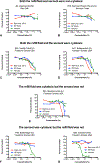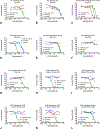Comparing the cytotoxicity of electronic cigarette fluids, aerosols and solvents
- PMID: 28596276
- PMCID: PMC6397802
- DOI: 10.1136/tobaccocontrol-2016-053472
Comparing the cytotoxicity of electronic cigarette fluids, aerosols and solvents
Abstract
Background: As thousands of electronic cigarette (e-cigarette) refill fluids continue to be formulated and distributed, there is a growing need to understand the cytotoxicity of the flavouring chemicals and solvents used in these products to ensure they are safe. The purpose of this study was to compare the cytotoxicity of e-cigarette refill fluids/solvents and their corresponding aerosols using in vitro cultured cells.
Methods: E-cigarette refill fluids and do-it-yourself products were screened in liquid and aerosol form for cytotoxicity using the MTT (3-(4,5-dimethylthiazol-2-yl)-2,5-diphenyltetrazolium bromide) assay. The sensitivity of human pulmonary fibroblasts, lung epithelial cells (A549) and human embryonic stem cells to liquids and aerosols was compared. Aerosols were produced using Johnson Creek's Vea cartomizer style e-cigarette.
Results: A hierarchy of potency was established for the aerosolised products. Our data show that (1) e-cigarette aerosols can produce cytotoxic effects in cultured cells, (2) four patterns of cytotoxicity were found when comparing refill fluids and their corresponding aerosols, (3) fluids accurately predicted aerosol cytotoxicity 74% of the time, (4) stem cells were often more sensitive to aerosols than differentiated cells and (5) 91% of the aerosols made from refill fluids containing only glycerin were cytotoxic, even when produced at a low voltage.
Conclusions: Our data show that various flavours/brands of e-cigarette refill fluids and their aerosols are cytotoxic and demonstrate the need for further evaluation of e-cigarette products to better understand their potential health effects.
Keywords: aerosol; cytotoxicity; electronic cigarettes; flavors; refill fluid; vegetable glycerin.
© Article author(s) (or their employer(s) unless otherwise stated in the text of the article) 2018. All rights reserved. No commercial use is permitted unless otherwise expressly granted.
Conflict of interest statement
Competing interests: None declared.
Figures




Similar articles
-
Distribution, quantification and toxicity of cinnamaldehyde in electronic cigarette refill fluids and aerosols.Tob Control. 2016 Nov;25(Suppl 2):ii94-ii102. doi: 10.1136/tobaccocontrol-2016-053224. Epub 2016 Sep 15. Tob Control. 2016. PMID: 27633763 Free PMC article.
-
Comparison of electronic cigarette refill fluid cytotoxicity using embryonic and adult models.Reprod Toxicol. 2012 Dec;34(4):529-37. doi: 10.1016/j.reprotox.2012.08.001. Epub 2012 Aug 20. Reprod Toxicol. 2012. PMID: 22989551
-
Analytical and toxicological evaluation of flavor chemicals in electronic cigarette refill fluids.Sci Rep. 2018 May 29;8(1):8288. doi: 10.1038/s41598-018-25575-6. Sci Rep. 2018. PMID: 29844439 Free PMC article.
-
Chemical evaluation of electronic cigarettes.Tob Control. 2014 May;23 Suppl 2(Suppl 2):ii11-7. doi: 10.1136/tobaccocontrol-2013-051482. Tob Control. 2014. PMID: 24732157 Free PMC article. Review.
-
Electronic Cigarettes: Their Constituents and Potential Links to Asthma.Curr Allergy Asthma Rep. 2017 Oct 5;17(11):79. doi: 10.1007/s11882-017-0747-5. Curr Allergy Asthma Rep. 2017. PMID: 28983782 Free PMC article. Review.
Cited by
-
E-cigarette Aerosol Mixtures Inhibit Biomaterial-Induced Osseointegrative Cell Phenotypes.Materialia (Oxf). 2021 Dec;20:101241. doi: 10.1016/j.mtla.2021.101241. Epub 2021 Oct 8. Materialia (Oxf). 2021. PMID: 34778733 Free PMC article.
-
Identification of Cytotoxic Flavor Chemicals in Top-Selling Electronic Cigarette Refill Fluids.Sci Rep. 2019 Feb 26;9(1):2782. doi: 10.1038/s41598-019-38978-w. Sci Rep. 2019. PMID: 30808901 Free PMC article.
-
Electronic Cigarette Refill Fluids Sold Worldwide: Flavor Chemical Composition, Toxicity, and Hazard Analysis.Chem Res Toxicol. 2020 Dec 21;33(12):2972-2987. doi: 10.1021/acs.chemrestox.0c00266. Epub 2020 Nov 23. Chem Res Toxicol. 2020. PMID: 33225688 Free PMC article.
-
Aerosolized nicotine-free e-liquid base constituents exacerbates mitochondrial dysfunction and endothelial glycocalyx shedding via the AKT/GSK3β-mPTP pathway in lung injury models.Respir Res. 2025 Mar 1;26(1):82. doi: 10.1186/s12931-025-03155-3. Respir Res. 2025. PMID: 40025534 Free PMC article.
-
Ethyl maltol, vanillin, corylone and other conventional confectionery-related flavour chemicals dominate in some e-cigarette liquids labelled 'tobacco' flavoured.Tob Control. 2022 Nov;31(Suppl 3):s238-s244. doi: 10.1136/tc-2022-057484. Tob Control. 2022. PMID: 36328460 Free PMC article.
References
Publication types
MeSH terms
Substances
Grants and funding
LinkOut - more resources
Full Text Sources
Other Literature Sources
Medical
Research Materials
